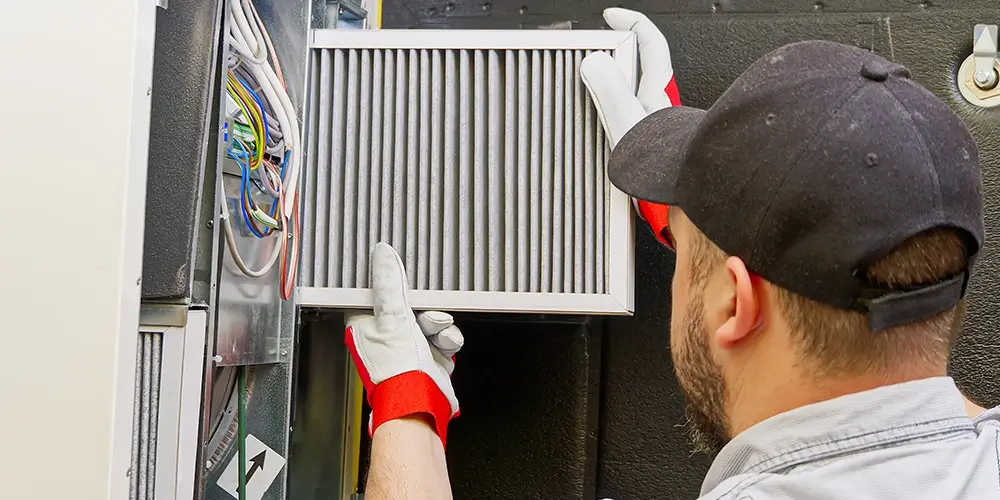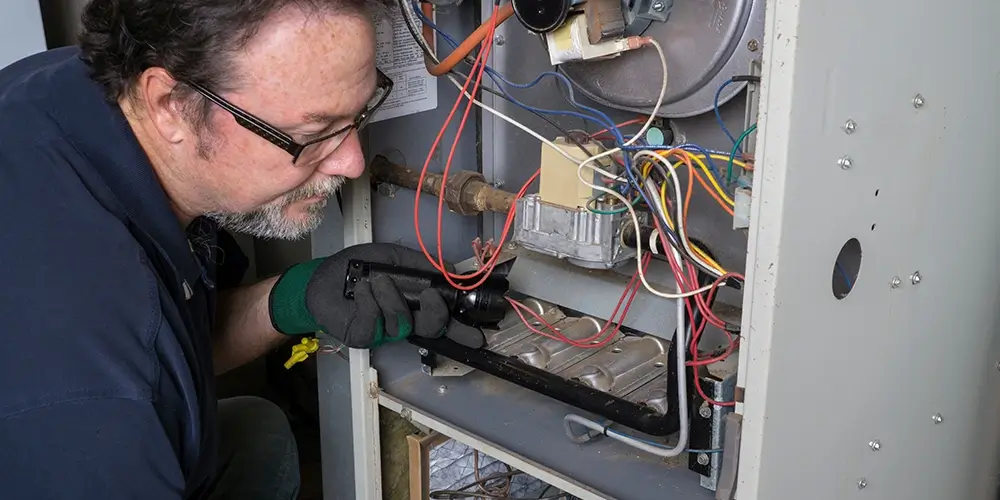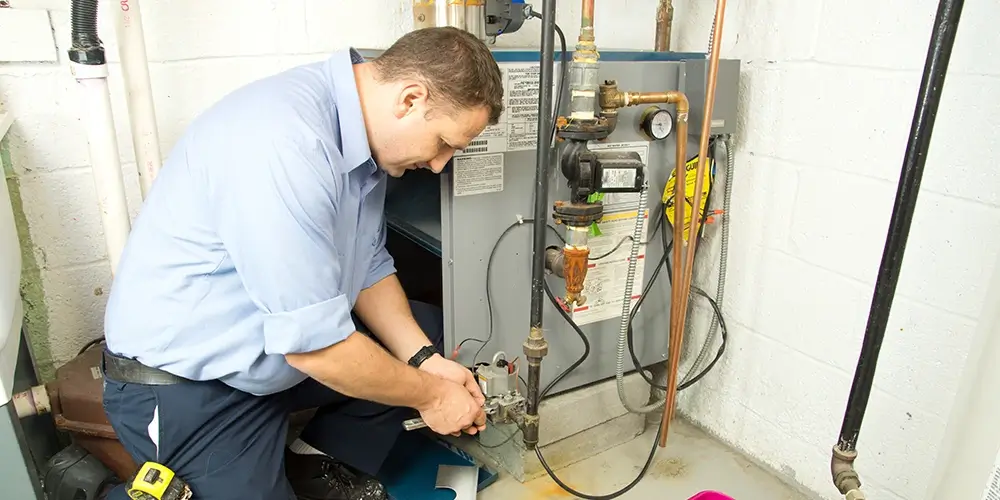Forced-Air Heating Repair & Installation

West Coast Chief repairs all brands and types of forced air furnaces, including:
- Electric furnaces
- Natural gas furnaces
- Propane furnaces
We also install new furnaces, along with ductwork. Even a well-maintained furnace has a service limit of about 20 years.
Our NATE-certified technicians will help you choose the best furnace for your budget, ensure that it’s appropriately sized for your home, and install it according to the manufacturer’s specifications.
Benefits of Forced-Air Heating
Forced air is the most popular type of heating in Southern California, bar none.
- A forced-air furnace heats your home quickly and evenly. It’s among the most energy-efficient furnaces you can buy.
- Forced-air furnaces are compatible with central air conditioning; many have built-in humidifiers to keep your home comfortable in the winter.
- Zoning lets you heat (or cool) different areas of your home independently, so you’re not wasting money heating unoccupied rooms.
- The furnace pulls in fresh outdoor air, improving indoor air quality.
- Filters in the ductwork or furnace catch dust, dander, and other allergens before they can circulate through your home.
- Pairing a smart thermostat with your forced-air furnaces saves energy and money.
Drawbacks of Forced-Air Heating
- Ductwork can be a source of leaks and a breeding ground for mold, mildew, and bacteria.
- The blower motor in a forced-air furnace is a mechanical component with moving parts, so it’s subject to wear.
- Electronic ignitions are also vulnerable to failure.
- If any part of the system breaks down, you could be without heat on a cold day.
- Forced-air furnaces are noisy; you’ll hear the blower running.
How Forced-Air Heating Works
A gas forced-air furnace has four main components:
- The burners, where fuel is combusted to generate heat.
- The heat exchanger, where combustion gases transfer their heat to the incoming air stream.
- The blower, which moves air through the furnace and ductwork.
- The flue, which exhausts combustion gases outdoors
In a gas furnace, the burners ignite the fuel (natural gas or propane), and a blower forces air over the heat exchanger. Air heats up as it passes through and circulates throughout the home via ductwork.
An electric forced-air furnace works on the same principle but uses electricity to generate heat instead of combustion. In both cases, a thermostat signals the furnace to turn on when the indoor temperature drops below the set point and to turn off when that set point is reached.

Signs Your Forced-Air Furnace Needs Repair
Even a well-maintained furnace will eventually need repairs. Here are some reasons to call us:
- Your furnace fails to generate heat or doesn’t turn on at all.
- Your furnace runs much longer than expected.
- The furnace shuts off prematurely.
- The furnace cycles on and off too frequently.
- The furnace makes strange noises.
- The pilot light keeps going out (gas furnaces only).
- There’s no hot air coming from the vents.
- Your thermostat isn’t working correctly.
- You see rust around the furnace or ductwork.
- Your energy bills keep rising, even when you run the furnace less often.
- You smell unpleasant odors near the furnace or coming from the vents.
Diagnosing & Repairing Your Furnace
Gas Forced-Air Furnaces
If the blower of your gas furnace doesn’t turn on, the problem may be due to the following:
- Blower motor
- Capacitor
- Thermostat
- Gas valve
- Furnace control board
If your gas forced-air furnace has no power and no breakers have been tripped, possible issues include:
- Furnace power transformer
- Furnace control board
- Thermostat
- Capacitor
- Blower motor
Electric Forced-Air Furnaces
Problems affecting electric furnaces often mirror those of their gas-fueled cousins. But we’ll also check for:
- Heating unit damage
- Loose wires and electrical connections

Repair vs. Replacement: When to Know
Sometimes, replacing your furnace makes more sense than repairing it.
- Your furnace is 15-20 years old. Even with regular maintenance, furnaces have a limited lifespan. If yours is approaching the end of its service life, a replacement will pay off in the long run.
- You need frequent repairs. If you’ve already spent several hundred dollars on repairs in the past year or two, replacement might be a better option.
- The repair will cost nearly as much as a new furnace. In this case, you might get a new furnace with a warranty instead of gambling on an older one.
- You’re not getting enough heat. If your furnace isn’t heating your home adequately, even when well-maintained, it’s time for a new one.
- You want to upgrade to a more efficient model. New furnaces are much more energy-efficient than older models, saving you money on utility bills. Some utility companies offer rebates for installing ENERGY STAR appliances.
Our certified technicians can help you weigh the pros and cons of each option so that you can make the best decision for your home and budget. Contact us today to schedule a consultation!
Regular Maintenance Extends the Life of Your Furnace
A furnace is a major appliance; like any appliance, it needs regular care and maintenance to function optimally.
At least once a year, preferably in the fall, hire a technician to check and clean your furnace. This tune-up will keep it running efficiently and catch any potential problems early on.
You should also change the air filter every month or two. A dirty filter restricts airflow and makes the furnace work harder, which wastes energy and wears the furnace out.
If you have a gas furnace, check the pilot light periodically to make sure it’s lit.
For gas and electric furnaces, keep an eye out for any strange noises or odors coming from the furnace or vents. These could be signs of a problem.
Take good care of your furnace, and your furnace will take care of you for many years to come.
New Furnace Installation
Furnace installation is a job for professionals. A faulty installation can void the warranty, precipitate expensive repairs, create inefficiency in your heating system, and even pose a fire hazard.
Our certified technicians will help you choose the perfect model for your home and budget. We’ll handle the entire process from start to finish, so you don’t have to lift a finger.
Installing a new furnace is a significant investment, but it always pays off in increased comfort and reduced energy bills. Call us today to get started!
